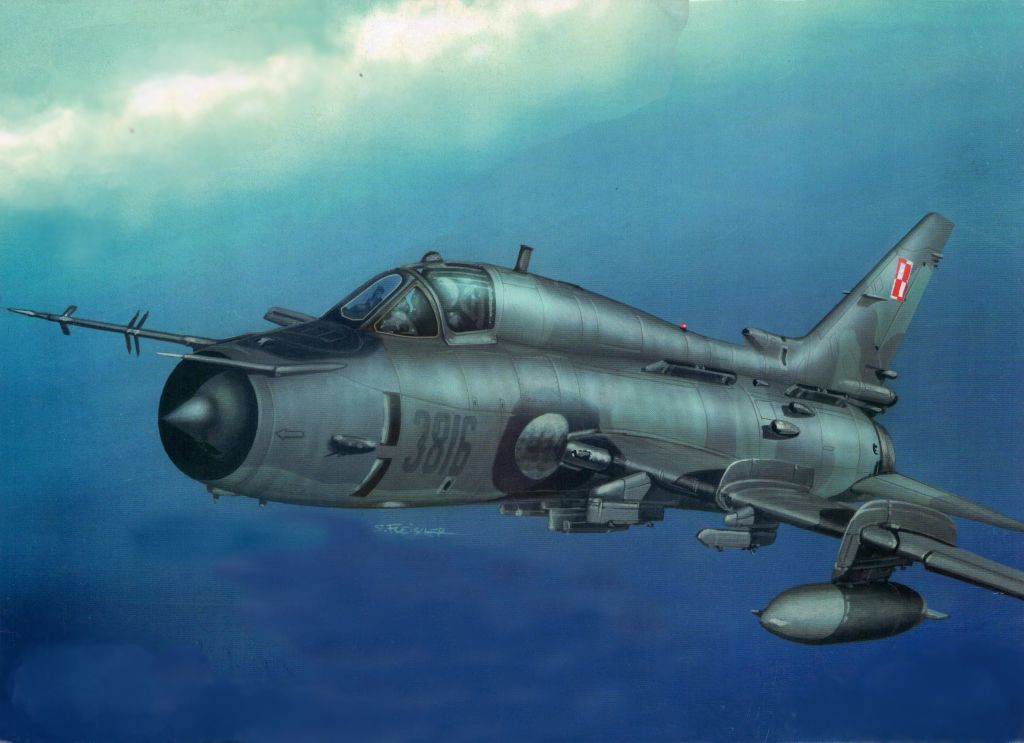
History
In 1956 the Sukhoi design bureau created its first tactical jet bomber, the Su-7, a modern-looking machine built in large numbers to offset its relative simplicity. It was a capable fighter-bomber and ruggedly built but also somewhat underpowered. Moreover, it suffered from long runway rolls and rather short range. In 1967 the Sukhoi bureau decided to upgrade this family of bombers by adding variable-geometry wings to enhance takeoff, landing, and load-carrying abilities. Early on it was judged impossible to fit wing-retracting equipment into the narrow fuselage, so engineers compromised by making the wings pivot midway along their length. The added lift increased the Su-7’s takeoff performance, and operational radius and ordnance payload were improved as well. Commencing in 1971 the new Su-17 became operational in large numbers, and they were deployed by Warsaw Pact allies and Soviet client states. It has since received the NATO designation FITTER.
During the past three decades, the basic Su-17 design has undergone numerous modifications and upgrades that render this marginally obsolete machine still useful as an attack craft. The latest variant, the Su-17M, is distinguished by a close-fitting clamshell canopy with a high spine ridge running the length of the fuselage. The tail fin is also somewhat taller and employs a single airscoop at its base. This model has been exported abroad as the Su-22, with somewhat lowered-powered avionics, but otherwise it remains an effective bombing platform. After the breakup of the Soviet Union in the late 1980s, many former Warsaw Pact countries were eager to unload their aging Sukhois, but Russia alone seems content to maintain its stable of 800-plus Su-17s. Their rugged design, combined with good reliability and performance, ensures a long service life.
Polish Air Force
On 19 August 2003, a Polish Air Force Su-22M4K was accidentally shot down by friendly fire during an exercise by a Polish 2K12 Kub battery. The aircraft was flying 21 km from the coast over the Baltic Sea near Ustka. The pilot ejected and was rescued after two hours in the water. He later died in a C-295M crash on 23 January 2008. As of 2012, Poland was planning to replace its Su-22s with three squadrons of drones.
As of 2014 the Polish Air Force was planning to retain the Su-22s in service. It is hoped that this decision will have a positive impact on Polish industry, as the WZL nr 2 repair facility in Bydgoszcz will maintain the remaining aircraft under contract to the Air Force. The decision would also allow the Air Force to retain the well-trained ground crews and pilots, currently operating the machines. The Poles consider the Su-22 easier to maintain and repair than the other main combat aircraft types currently in Polish service (mainly the MiG-29 and the F-16). They also suffer from fewer malfunctions and other problems (high, 70–75% non-error index). It is also the only plane in Polish inventory equipped for electronic intelligence, warfare, and support of ground systems. The Polish Air Force has retained a large stockpile of air-to-ground weapons for use with the Su-22. By some estimates, the cost of destroying these resources would be higher than the projected cost of continuing Su-22 operations. It was decided that starting from 2015, only 12 Su-22M4 and 4-6 Su-22UM3K out of 32 remaining would undergo a refit, increasing their lifespan for another ten years. For economical reasons the aircraft are not modernized, apart from fitting an additional radio RS-6113-2 C2M with a blade antenna on the top, but they receive a new grey multishade camouflage, similar to other Polish aircraft.
Su-17UM3 (S-52UM3, “Fitter-G”)
Revised trainer with the same avionics suite as the Su-17M3. First flight: 21 September 1978 with Yu. A. Yegorov at the controls. The export version was designated Su-22UM3 with R-29 engine, and Su-22UM3K with the AL-21 engine. Manufactured 1978–1982.
Su-17M4 (S-54, “Fitter-K”)
Final production version with considerably upgraded avionics, including RSDN navigation (similar to LORAN), beacon navigation, inertial navigation, a more powerful (Klyon) “Kлён-54” laser rangefinder, radio compass, and SPO-15LE (“Sirena”) radar-warning system. Additional fuselage inlets (including ram-air inlet at the base of the fin) to improve engine cooling airflow, fixed air intake shock cone. Many aircraft were equipped for the use of TV-guided missiles and BA-58 Vjuga pod for anti-radiation missiles. AL-21F-3 engine. Export version was designated Su-22M4 (factory S-54K). First flight: 19 June 1980 with Yu. A. Yegorov at the controls. Su-17M4 was manufactured 1981–1988, Su-22M4 was manufactured 1983–1990.
Sukhoi SU-17M4/22M4
Russian aircraft builders display great ingenuity in wringing every last ounce of performance from existing machines. The long-lived Su-17 is such an example, and it continues to be upgraded and employed long after the basic design became obsolete.